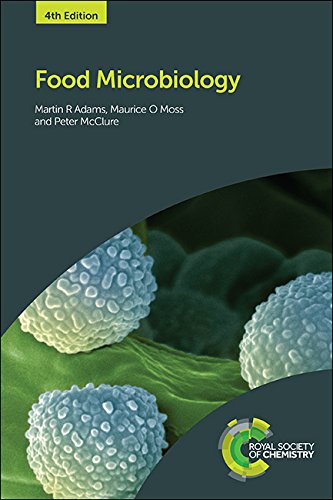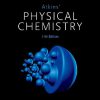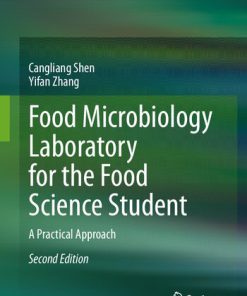Food Microbiology 4th Edition by Martin Adams, Maurice Moss, Peter McClure ISBN 9781849739603 1849739609
$50.00 Original price was: $50.00.$25.00Current price is: $25.00.
Food Microbiology 4th Edition by Martin Adams, Maurice Moss, Peter McClure – Ebook PDF Instant Download/Delivery: 9781849739603 ,1849739609
Full download Food Microbiology 4th Edition after payment

Product details:
ISBN 10: 1849739609
ISBN 13: 9781849739603
Author: Martin Adams, Maurice Moss, Peter McClure
Food Microbiology by Adams and Moss has been a popular textbook since it was first published in 1995. Now in its fourth edition, Peter McClure joins the highly successful authorship in order to bring the book right up to date.
Maintaining its general structure and philosophy to encompass modern food microbiology, this new edition provides updated and revised individual chapters and uses new examples to illustrate incidents with particular attention being paid to images. Thorough and accessible, it is designed for students in the biological sciences, biotechnology and food science as well as a valuable resource for researchers, teachers and practising food microbiologists.
Food Microbiology 4th Edition Table of contents:
Chapter 1 The Scope of Food Microbiology
1.1 Micro-organisms and Food
1.1.1 Food Spoilage/Preservation
1.1.2 Food Safety
1.1.3 Fermentation
1.2 Microbiological Quality Assurance
Chapter 2 Micro-organisms and Food Materials
2.1 Diversity of Habitat
2.2 Micro-organisms in the Atmosphere
2.2.1 Airborne Bacteria
2.2.2 Airborne Fungi
2.3 Micro-organisms of Soil
2.4 Micro-organisms of Water
2.5 Micro-organisms of Plants
2.6 Micro-organisms of Animal Origin
2.6.1 The Skin
2.6.2 The Nose and Throat
2.7 Conclusions
Chapter 3 Factors Affecting the Growth and Survival of Micro-organisms in Foods
3.1 Microbial Growth
3.2 Intrinsic Factors (Substrate Limitations)
3.2.1 Nutrient Content
3.2.2 pH and Buffering Capacity
3.2.3 Redox Potential, Eh
3.2.4 Antimicrobial Barriers and Constituents
3.2.5 Water Activity
3.3 Extrinsic Factors (Environmental Limitations)
3.3.1 Relative Humidity
3.3.2 Temperature
3.3.3 Gaseous Atmosphere
3.4 Implicit Factors
3.5 Predictive Food Microbiology
Chapter 4 The Microbiology of Food Preservation
4.1 Heat Processing
4.1.1 Pasteurization and Commercial Sterilization (Appertization)
4.1.2 Quantifying the Thermal Death of Micro-organisms: D and z Values
4.1.3 Heat Sensitivity of Micro-organisms
4.1.4 Describing a Heat Process
4.1.5 Spoilage of Canned Foods
4.1.6 Aseptic Packaging
4.2 Irradiation
4.2.1 Microwave Radiation
4.2.2 UV Radiation
4.2.3 Ionizing Radiation
4.3 High-pressure Processing – Pascalization
4.4 Low-temperature Storage – Chilling and Freezing
4.4.1 Chill Storage
4.4.2 Freezing
4.5 Chemical Preservatives
4.5.1 Organic Acids and Esters
4.5.2 Nitrite
4.5.3 Sulfur Dioxide
4.5.4 Natamycin
4.5.5 ‘Natural’ Food Preservatives
4.6 Modification of Atmosphere
4.7 Control of Water Activity
4.8 Compartmentalization
Chapter 5 Microbiology of Primary Food Commodities
5.1 What is Spoilage?
5.2 Milk
5.2.1 Composition
5.2.2 Microflora of Raw Milk
5.2.3 Heat Treatment of Milk
5.2.4 Milk Products
5.3 Meat
5.3.1 Structure and Composition
5.3.2 The Microbiology of Primary Processing
5.3.3 Spoilage of Fresh Meat
5.4 Fish
5.4.1 Structure and Composition
5.4.2 The Microbiology of Primary Processing
5.4.3 Crustaceans and Molluscs
5.4.4 Spoilage of Fresh Fish
5.5 Plant Products
5.5.1 Cereals
5.5.2 Preservation of High-moisture Cereals
5.5.3 Pulses, Nuts and Oilseeds
5.5.4 Fruits and Fruit Products
5.5.5 Vegetables and Vegetable Products
Chapter 6 Food Microbiology and Public Health
6.1 Food Hazards
6.2 Significance of Foodborne Disease
6.3 Incidence of Foodborne Illness
6.4 Risk Factors Associated with Foodborne Illness
6.5 The Changing Scene and Emerging Pathogens
6.6 The Site of Foodborne Illness. the Alimentary Tract: its Function and Microflora
6.7 The Pathogenesis of Diarrhoeal Disease
Chapter 7 Bacterial Agents of Foodborne Illness
7.1 Aeromonas hydrophila
7.1.1 Introduction
7.1.2 The Organism and its Characteristics
7.1.3 Pathogenesis and Clinical Features
7.1.4 Isolation and Identification
7.1.5 Association with Foods
7.2 Bacillus cereus and Other Bacillus Species
7.2.1 Introduction
7.2.2 The Organism and its Characteristics
7.2.3 Pathogenesis and Clinical Features
7.2.4 Isolation and Identification
7.2.5 Association with Foods
7.3 Brucella
7.3.1 Introduction
7.3.2 The Organism and its Characteristics
7.3.3 Pathogenesis and Clinical Features
7.3.4 Isolation and Identification
7.3.5 Association with Foods
7.4 Campylobacter
7.4.1 Introduction
7.4.2 The Organism and its Characteristics
7.4.3 Pathogenesis and Clinical Features
7.4.4 Isolation and Identification
7.4.5 Association with Foods
7.5 Clostridium botulinum
7.5.1 Introduction
7.5.2 The Organism and its Characteristics
7.5.3 Pathogenesis and Clinical Features
7.5.4 Isolation and Identification
7.5.5 Association with Foods
7.6 Clostridium perfringens
7.6.1 Introduction
7.6.2 The Organism and its Characteristics
7.6.3 Pathogenesis and Clinical Features
7.6.4 Isolation and Identification
7.6.5 Association with Foods
7.7 Cronobacter Species
7.7.1 Introduction
7.7.2 The Organism and its Characteristics
7.7.3 Pathogenesis and Clinical Features
7.7.4 Isolation and Identification
7.7.5 Association with Foods
7.8 Escherichia coli
7.8.1 Introduction
7.8.2 The Organism and its Characteristics
7.8.3 Pathogenesis and Clinical Features
7.8.4 Isolation and Identification
7.8.5 Association with Foods
7.9 Listeria monocytogenes
7.9.1 Introduction
7.9.2 The Organism and its Characteristics
7.9.3 Pathogenesis and Clinical Features
7.9.4 Isolation and Identification
7.9.5 Association with Foods
7.10 Mycobacterium Species
7.10.1 Introduction
7.10.2 The Organism and its Characteristics
7.10.3 Pathogenesis and Clinical Features
7.10.4 Isolation and Identification
7.10.5 Association with Foods
7.11 Plesiomonas shigelloides
7.11.1 Introduction
7.11.2 The Organism and its Characteristics
7.11.3 Pathogenesis and Clinical Features
7.11.4 Isolation and Identification
7.11.5 Association with Foods
7.12 Salmonella
7.12.1 Introduction
7.12.2 The Organism and its Characteristics
7.12.3 Pathogenesis and Clinical Features
7.12.4 Isolation and Identification
7.12.5 Association with Foods
7.13 Shigella
7.13.1 Introduction
7.13.2 The Organism and its Characteristics
7.13.3 Pathogenesis and Clinical Features
7.13.4 Isolation and Identification
7.13.5 Association with Foods
7.14 Staphylococcus aureus
7.14.1 Introduction
7.14.2 The Organism and its Characteristics
7.14.3 Pathogenesis and Clinical Features
7.14.4 Isolation and Identification
7.14.5 Association with Foods
7.15 Vibrio
7.15.1 Introduction
7.15.2 The Organisms and their Characteristics
7.15.3 Pathogenesis and Clinical Features
7.15.4 Isolation and Identification
7.15.5 Association with Foods
7.16 Yersinia enterocolitica
7.16.1 Introduction
7.16.2 The Organism and its Characteristics
7.16.3 Pathogenesis and Clinical Features
7.16.4 Isolation and Identification
7.16.5 Association with Foods
7.17 Scombrotoxic Fish Poisoning
7.18 Conclusion
Chapter 8 Non-bacterial Agents of Foodborne Illness
8.1 Helminths and Nematodes
8.1.1 Platyhelminths: Liver Flukes and Tapeworms
8.1.2 Roundworms
8.2 Protozoa
8.2.1 Giardia lamblia
8.2.2 Entamoeba histolytica
8.2.3 Sporozoid Protozoa
8.3 Toxigenic Algae
8.3.1 Dinoflagellate Toxins
8.3.2 Cyanobacterial Toxins
8.3.3 Toxic Diatoms
8.4 Toxigenic Fungi
8.4.1 Mycotoxins and Mycophagy
8.4.2 Mycotoxins of Aspergillus
8.4.3 Mycotoxins of Penicillium
8.4.4 Mycotoxins of Fusarium
8.4.5 Mycotoxins of Other Fungi
8.5 Foodborne Viruses
8.5.1 Polio
8.5.2 Hepatitis A and E
8.5.3 Gastroenteritis Viruses
8.5.4 Sources of Food Contamination
8.5.5 Control
8.6 Spongiform Encephalopathies
Chapter 9 Fermented and Microbial Foods
9.1 Introduction
9.2 Yeasts
9.3 Lactic Acid Bacteria
9.4 Activities of Lactic Acid Bacteria in Foods
9.4.1 Antimicrobial Activity of Lactic Acid Bacteria
9.4.2 Health-promoting Effects of Lactic Acid Bacteria-Probiotics
9.4.3 The Malo-lactic Fermentation
9.5 Fermented Milks
9.5.1 Yoghurt
9.5.2 Other Fermented Milks
9.6 Cheese
9.7 Fermented Plant Products
9.7.1 Sauerkraut and Kimchi
9.7.2 Olives
9.7.3 Cucumbers
9.7.4 Fermented Legumes
9.8 Fermented Meats
9.9 Fermented Fish
9.10 Beer
9.11 Vinegar
9.12 Mould Fermentations
9.12.1 Tempeh
9.12.2 Soy Sauce and Rice Wine
9.12.3 Mycoprotein
9.13 Conclusion
Chapter 10 Methods for the Microbiological Examination of Foods
10.1 Microbiological Quality and Indicator Organisms
10.2 Direct Examination
10.3 Cultural Techniques
10.4 Enumeration Methods
10.4.1 Plate Counts
10.4.2 Most Probable Number Counts
10.5 Alternative Methods
10.5.1 Chemical Analysis
10.5.2 Dye-reduction Tests
10.5.3 Electrical Methods
10.5.4 ATP Determination
10.6 Rapid Methods for the Detection of Specific Organisms and Toxins
10.6.1 Immunological Methods
10.6.2 DNA/RNA Methodology
10.6.3 Subtyping
10.7 Quality Assurance of Laboratory Performance
10.7.1 Use of Validated Methods
10.7.2 Laboratory Accreditation
Chapter 11 Controlling the Microbiological Quality of Foods
11.1 Quality and Criteria
11.2 Sampling Schemes
11.2.1 Two-class Attributes Plans
11.2.2 Three-class Attributes Plans
11.2.3 Choosing a Plan Stringency
11.2.4 Variables Acceptance Sampling
11.3 Quality Control Using Microbiological Criteria
11.4 Control at Source
11.4.1 Training
11.4.2 Facilities and Operations
11.4.3 Equipment
11.4.4 Cleaning and Disinfection
11.5 Codes of Good Manufacturing Practice
11.6 The Hazard Analysis and Critical Control Point (HACCP) Concept
11.6.1 Hazard Analysis
11.6.2 Identification of Critical Control Points (CCPs)
11.6.3 Establishment of CCP Critical Limits
11.6.4 Monitoring Procedures for CCPs
11.6.5 Protocols for CCP Deviations
11.6.6 Verification
11.6.7 Record Keeping
11.6.8 Review HACCP Plan
11.7 Quality Systems: BS 5750 and ISO 9000 Series
11.8 Risk Analysis
Chapter 12 Further Reading
Information Sources on the Internet
Subject Index
People also search for Food Microbiology 4th Edition:
define food microbiology
scope of food microbiology
father of food microbiology
international journal of food microbiology abbreviation
bacteria in food microbiology
Tags:
Martin Adams,Maurice Moss,Peter McClure,Food Microbiology
You may also like…
Biology and other natural sciences - Microbiology
Textbook of Microbiology and Immunology 4th ed 4th Edition Subhash Chandra Parija
Biology and other natural sciences - Microbiology
Textbook of Microbiology and Immunology 4th Edition Subhash Chandra Parija
Biology and other natural sciences - Microbiology
Textbook of Diagnostic Microbiology Sixth Edition Connie R. Mahon
Biology and other natural sciences - Microbiology
Textbook of diagnostic microbiology 7th Edition by Connie R. Mahon 9780323832717 0323832717
Biology and other natural sciences - Biotechnology
Nanotechnological Approaches in Food Microbiology 1st Edition Sanju Bala Dhull (Editor)
Biology and other natural sciences - Microbiology
Fiction - Myths & Folklore
Uncategorized










